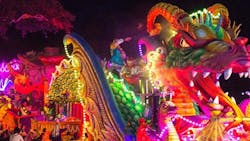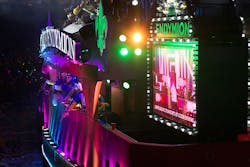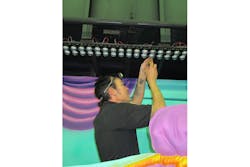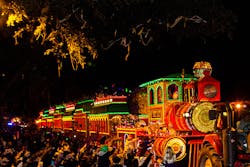Mardis Gras: American Tradition Powered by Electricians
You can see how America celebrates its independence on the Fourth of July, but you should go to New Orleans for Mardis Gras to really witness people acting free. On average, 1.4 million people are drawn to its intoxicating illumination every year, like debauchery-seeking moths to a jazz-infused flame. They drink, eat, party, and partake in activates you'll have to stumble down Bourbon Street to find out.
The beads tradition is a bit overblown, but the live brass music, sidewalk gumbo, po' boys, muffalettas, saccharine Hurricanes, Hollywood-topping costumes—all as American as pecan pie. Nothing, though, screams over-the-top American like the cavalcade of parade floats.
Photo: Kern Studios
These giant mashups of Halloween and Christmas, community and individuality, even dreams and nightmares, begin crawling through the Big Easy's main thoroughfares starting weeks before the actual big day, Fat Tuesday. But designing and engineering these colorful, brightly lit behemoths goes on the whole year.
The production of these floats, decked out with rows of elaborate LEDs and fiber optics to make their dragons and Greek gods come to life, are what pulled Klein Tools to the Crescent City this January to kick off its video series spotlighting the truly American events that rely on electricians.
"People think about electricians and they think, 'Oh, that's someone who puts it in an outlet or puts up a fan or wires buildings,'" says Greg Palese, Klein's VP of marketing. "But we knew there was a whole 'nother segment of people out there doing different and interesting jobs and always sort of want to focus on them."
It wasn't until Palese visited Kern Studios, which makes 450 floats a year, that he truly understood just how important electricians were to making the floats. And Klein's pliers and precision screwdrivers, along with multimeters, wire cutters and wire strippers, were also on hand to fit into those wooden and Styrofoam nooks and crannies.
Watch the video to see how it all comes together.
These giant mashups of Halloween and Christmas, community and individuality, even dreams and nightmares, begin crawling through the Big Easy's main thoroughfares starting weeks before the actual big day, Fat Tuesday. But designing and engineering these colorful, brightly lit behemoths goes on the whole year.
While the local social groups called krewes get all the attention and envy from onlookers as they hurl their throws (beads, tchotchkes, and plastic doubloons) from the multi-level floats, Palese learned it’s the electricians who energize these projects.
Kern studios electricians rely on small precision screwdrivers
such as the ones Klein Tools manufacturers to get the job.
Photo: Klein Tools
"We were definitely surprised by the detail and intricacy," recalls Palese, adding it could take 12 hours of wiring and teams of six to complete some of the jobs.
He describes mounds of wire winding through the narrow corridors atop each chassis, the amount you'd find in a small house. They connect 25-30 kW generators to sound systems, internal lighting for the bar area and bathrooms (the rides do last around four hours), the sound system, and of course, those lights.
"That's a lot more than we ever thought was going on," Palese says. "But these guys, they keep track of it all. They make sure it's all wired correctly. Nobody wants to see any flames driving down Bourbon Street."
Palese was also surprised at the level of manufacturing overall applied to the floats.
"They took us into the room again the room that sort of had the robotic arm that carves away these really intricate Styrofoam designs," says Palese, who has seen his fair share of automation at Klein's American-based manufacturing plants, which are a far cry from the tool maker's humble beginnings.
The company started 160 years ago when German immigrant Matthias Klein, an accomplished metalworker, fixed a pair of pliers for a telegraph lineman. Fittingly, 1857 was when New Orleans celebrated its first official Mardi Gras parade, an event credited with saving the tradition in New Orleans.
Photo: Kern Studios
The parade itself has branched out to several events throughout the Carnival season, including a PG-version parade a few weeks prior to the raucous grand finale.
For Palese, getting to meet the trades workers dripping the sweat equity into these symbols of freedom and revelry was the most interesting part.
"That's the beauty of this whole campaign and some of the work that we're doing ," he says. "We're discovering how intricate some of this work is and how talented a lot of the electricians are who are working on these on these projects."
Next up, Klein Tools plans on highlighting the electricians who make state fairs go round and round all summer, as well as the people who make sure the Friday night lights stay on all football season.
"It's sort of our version of Mike Rowe's Dirty Jobs," Palese says. "All these all those jobs that he went and explored and showed people doing all these crazy things. We've seen our share of places and events where electricians equipped with Klein gear are making all these amazing things happen, too."
Visit the NED Directory to take a look at Klein Tools' array of tools to help keep America bright.
This article was originally published on New Equipment Digest.




